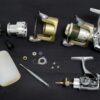Disclosure: Some posts contain affiliate links, which earn us a commission if you make a purchase through them. Positive Fishing © participates in various affiliate networks including the Amazon Services LLC Associates Program.
If you are planning a predator fishing trip, What predator fish species are out there to target?
For most European waters, the answer is straightforward: pike, perch, zander, and catfish. In the United States, anglers’ favourite is the bass species. Trout is also a predator fish and can be found widespread across the globe.
Although these are not the only predatory species available, they possess the abundance, size, strength, cunningness, and beauty that make them an ultimate goal of an avid predator angler!
I have spent my life in eternal pursuit of these mysterious monsters from murky depths of both lakes and rivers. I have had some noteworthy results in my angling history. In this article, I will share some of my knowledge of freshwater predatory fish species.
Let Us Learn More!
We will start with the smaller, abundant, and beginner-friendly predators. Then we will advance to those bigger, more scarce, and demanding species you have always dreamt about!
Perch
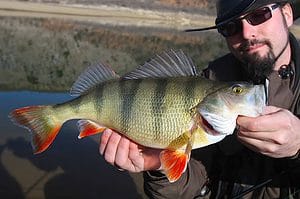
Perch is a predator that can grow up to 60 cm, with a record weight of 3.75 kg fish which was caught in the Netherlands. Perch size varies greatly depending on the body of water you are fishing.
Huge fish are often seen in fishing magazines, blogs, etc., and usually come from the Baltic Sea, which has very low salinity and offers a diet of Baltic herrings that enables perch to grow rapidly to a large size.
The average perch in most continental waters is around 15 cm long. Fish over 30 cm are considered big, while fish of 40cm + is considered a trophy!
Although they are not big, they make it up with abundance – a good body of water can give you a whole day of fun with little effort or knowledge needed! You will find perch in all types of lakes, from deep gravel pits to shallow and marshy ponds. They also inhabit slow-running rivers, no matter the size and depth! On the other hand, they hate cold, fast-flowing water (although they still might venture there).
Perch are bottom-dwelling fish, and they love ambush areas. Water grass, sunken trees, big rocks, drop-offs, or any underwater construction that provides cover and shade will most likely hold some perch!
Perch do not love the sun. Their big eyes are adapted to hunting in low light conditions, and they are most active at dusk or dawn when you can find them scattered all over the water column. If the day is cloudy, they will remain active near the bottom or suspended under drop-offs. But if there is sun, perch will seek the cover of shade or depth, and you will have to find where they are.
This stripy little predator lives in schools, and numbers grow less as the average perch size increases. This means there is always a competition for food when the school is hunting, which is great for you as an angler!
When you find a school of perch, fishing can escalate into a frenzy in no time – they will keep hitting your lures/baits! And when bites start getting scarce, you can always search for another school.
When starting your predator fishing journey, your efforts must be quickly rewarded. This is why perch is a great fish to explore your predator fishing skills!
Pike
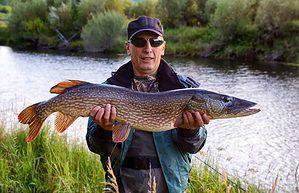
Pike is the most notorious freshwater predator! It can grow to a stunning 150 cm with a weight of up to 30kg and carries a killing instinct unmatched by any European predator species!
It shares the same fate as perch, reaching larger sizes in the abundance of low salinity waters of the Baltic but also getting quite big on most inland Euro-Asian waters. Average fish is in the 50 cm range; 80 cm+ fish are considered to be of good size, while 100 cm+ is the size of a trophy fish!
Pike inhabit almost all water bodies imaginable! They prefer shallow, warm, and grassy waters but will also dwell in deep, cold lakes and rivers. They even go to the trout territory if they somehow end up there. But generally, they prefer slow-running rivers and lakes to faster streams.
Being an ambush hunter, the pike is closely connected to available hiding spots. They have incredible acceleration when attacking and can spend prolonged time hidden in the grass or under a sunken tree, waiting for the opportunity to strike. When the prey enters their sight, the attack will be lightning-fast and savage – their toothy jaws will make an instant mess of anything unfortunate enough to end up there!
That is why you always need to search pike near potential hiding spots – tree structures are the best option, but big rocks, lily pads, drop-offs, peers, and similar structures will also hold pike!
What makes pike unique is their incredible hunting instincts. Pikes are fierce predators, capable of attacking everything that moves in the water – it doesn’t matter if the target of an attack is a fish, a duck, or a rat! It also does not matter if the prey is big; pike have big jaws and even bigger appetites and will attack prey that is literally the same size as they are!
They tend to be more active when roaming the hunting grounds at dusk and dawn. But they will eagerly attack your lure/bait during the day, especially if the weather is cloudy!
Pike will never share their habitat with other pikes, as they are cannibals and attack fish entering their territory.
Due to the pronounced aggression and willingness to hit almost any kind of lure or live bait available, pike are a perfect predator fish for anglers of all skill levels!
Zander
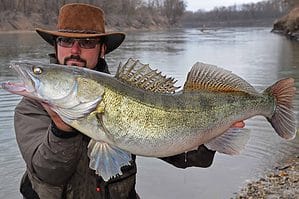
Meet the king of cunningness – the elusive zander! A predator that resembles a combination of both pike and perch and can grow to a stunning 120 cm and 20 kg weight!
The average zander is around 50 cm long; fish over 70 cm are good-sized, while anything over 90 cm is a trophy fish! They are often larger in rivers than in lakes.
They inhabit large, slow-flowing rivers and big lakes. Unlike the zander, they prefer scarce vegetation and are very sensitive to oxygen levels, being unable to survive in eutrophic conditions.
Zander is incredibly adapted to hunting in low-light conditions! They will often dwell in the deepest parts of lakes and rivers and reserve their hunting activities for night hours. When dusk starts setting in, zander will leave their daily habitat and start approaching their night hunting grounds near the margins, where they will be active until dawn.
Although they hunt at night, they can be caught in their daily habitat and at night hunting grounds. Fishing is especially successful during overcast weather and in murky water, where zander uses their excellent sight and lateral line to detect prey.
Zander prefers hunting from cover. In rivers, you will find them under drop-offs, behind sand dunes and sunken trees, and in calm water pockets surrounded by turbulent water.
In lakes, they will be in deep water, often suspended, and hunt near sunken obstacles, especially on the edge of shallow areas where prey is often concentrated.
Zander’s sensitivity to presentation, bait, tackle choice, and many other factors make zander special. Zander rarely attacks loud and aggressive lures or big baits suited for pike and will be incredibly finicky to strong tackle. Beginners will often have problems even noticing a take on their lure and will have trouble with zander spitting out the bait before you can set the hook. It’s not the easiest predator fish to catch!
Although zander is not an easy target, putting your effort into catching one will pay off with the first realized strike!
You can understand more about zander fishing during the winter and the complexities of catching them.
Catfish
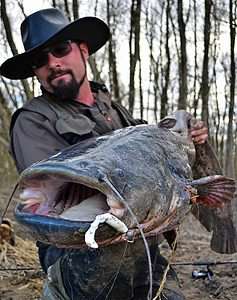
Meet the second-largest Euro-Asian saltwater predator – catfish! The literature claims it can reach a length of 3 meters and weight of 200 + kg, but the largest reported specimen is 144 kg and 2.78 m in length caught in river Po in Italy.
Due to living more than 50 years and growing rather fast, the average catfish is around 80-100 cm long. Fish over 150 cm are respectable specimens, while anything exceeding 200 cm is a trophy!
Catfish dwell in big, slow-flowing rivers and large lakes. They will steer clear from cold waters, preferring warmth due to their slow metabolism!
Catfish will find habitat in the deep holes on river bends, under sunken trees, or anywhere they can use as a shelter. This predator will stay dormant during cold winter months and will be most active during warm summer days – often hunting on the surface and patrolling the shallow water like a shark.
Small eyes and long whiskers are telltale signs of a night hunter. Catfish have very limited eyesight but a very well-developed sense of smell and movement. It will usually feed off the bottom (with the exception of warm summer days and summer thunderstorms that will get them up on the surface) and attack almost anything – from crabs and small fish to birds, big fish, and other catfish!
When fishing for catfish, one must be prepared for a potential monster on the other side of the line. Big water bodies always hide big fish; knowing what will take your bait/lure is extremely tough but not impossible. Catfish have enormous strength and endurance; successfully catching the big one is no child’s play. It is as close to big-game angling as freshwater fishing goes!
The best time to catch catfish is after rainy days when water levels rise. They will use murky waters to patrol the shoreline and aggressively feed on anything, and you will have the best chances of getting your bait in their path!
The Ebro River in Spain is one region renowned in Europe for huge catfish. In the United States, there are multiple locations for catching massive catfish, the Mississippi and Missouri Rivers being well known for producing some of the biggest.
Interested in more?
Fishing for these predator fish is very exciting and enjoyable. I hope this article inspires you to go out fishing for them and tell your stories!
If you have found some of the answers you were seeking while reading this article – or even better, developed an additional interest in the predator fishing world – Then please go and check out my guide on best baits and lures for predator fish.
- Winter Lure Fishing For Catching Zander In Rivers & Lakes - January 22, 2022
- What Is Bolognese Fishing? The Ultimate Guide To Bolo Fishing - December 29, 2021
- How To Catch Carp: The Best Carp Hookbaits Revealed - November 17, 2021

